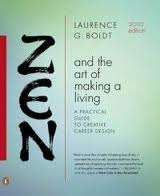Continuing to explore some recent encounters with ways of using life story to make career choices …
“… [T]o view your life as ‘nothing but the facts” is to miss an opportunity to for a marvelous adventure,” writes Laurence G. Boldt in Zen and The Art of Making A Living, “a conscious encounter with the universal energies and dilemmas of the human experience.”
Boldt devotes a chapter in his book to helping readers identify some of  these universal energies and how to “consciously, constructively, and artistically engage them on the way to creating your life’s work.” The chapter is about …
these universal energies and how to “consciously, constructively, and artistically engage them on the way to creating your life’s work.” The chapter is about …
… encouraging you: first to experience your life as myth, as a story of the individual encounter with the universal; second, and as a part of the first, to learn to recognize the universal or archetypal energies; third to develop your own creative relationship to those energies.
Myth, archetype, and symbol are the ways to approach “soul mysteries,” Boldt says, though his chapter deal primarily with the latter two elements, archetypes and symbols. (Archetypes are the raw material of myth, and symbols are is vocabulary, Boldt writes.)
Boldt presents four archetypes:
- Hero: Seeker of the Grail … Decider of Roads. Decision-making is an essential part of life.
- Magician: Showman … Shaman. Imagination is an essential part of life.
- Warrior: Horseman … Swordsman. Aggressive energy is an essential part of life.
- Scholar/Student-Sage: Child … Old Wise One. Learning and teaching are essential parts of life.
He acknowledges more archetypes than these but says these have been especially useful for creating life’s work.
The rest of the chapter delves more deeply into these four archetypes. In turn, the archetypes lay the foundation for the rest of the book and the themes of the Quest (Hero), the Game (Magician), the Battle (Warrior), and School of Life’s Work (Scholar/Student-Sage).
